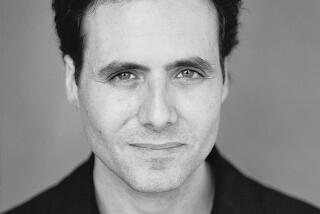A Kinsey Retrospective: His Two Studies Sparked the Sexual Revolution : Attitudes: The biologist’s reports on America’s bedroom habits exposed the country’s hypocritical past.
Alfred Charles Kinsey, crew cut, bow-tied, a Midwestern family man, opened the 20th Century to America like the doorkeeper Janus, god of passage.
Looking backward, he exposed a nation’s sexually hypocritical past; looking the other way, he started a dialogue on sexual behavior that continues today.
He turned up the lights with two books published smack dab in the middle of the century: “Sexual Behavior in the Human Male” (1948) and “Sexual Behavior in the Human Female” (1953). Sex was no longer in the dark.
What he said was almost as devastating as the fact he said it: America was preaching one morality and following quite another; measured by their own laws, many Americans were guilty of criminal sexual behavior.
He did not create the great sexual revolution of the 20th Century, but he chronicled it and aided and abetted it. Himself a man with a penchant for privacy, he opened the bedroom door, never to be shut again.
To many Americans, ridden with guilt, it undoubtedly came as a relief to realize that they were not alone in practicing what was taboo: adultery, masturbation, premarital sex, pregnancy before marriage, homosexual and bisexual proclivities.
But it shocked the scientific community and dismayed clerics. The work was found wanting in its statistical and ethical perspective. It left out love and said Americans practiced sex for enjoyment and not for procreation alone.
In short the Kinsey findings challenged the meaning of right and wrong, should and shouldn’t. Their impact?
Says Episcopal Bishop George Hunt of Providence, R.I., who has been helping his church wrestle with sexual questions for the last six years:
“I think it would be impossible to overestimate the impact of Kinsey. Leaving aside agreement or disagreement, the fact is he’s the first major person to popularize a conversation about human sexuality and make it possible for people to talk about it intelligently and somewhat dispassionately, if we ever get to that point. . . .
“But I think the door is open, and Kinsey should take credit for opening that door. And if we are not too impatient with ourselves, we may find that in say another generation that Kinsey improved our ability to understand ourselves and our ability to relate sexually to others.”
Still, as the 20th Century comes to a close, no study has matched the scope of Kinsey’s, which eventually encompassed about 20,000 interviews. Only recently, Secretary of Health and Human Services Louis W. Sullivan blocked a study of teen-agers that would have covered sexual behavior. He worried about the “inadvertent message” he thought conducting a sex survey would send. It would be contrary to his intention “to better communicate the message against casual sex,” he said.
An advisory council of the National Institutes of Health condemned the cancellation of the $18-million study, calling it “a dangerous precedent” that compromises the scientific integrity of NIH and “raises the specter of political veto” over the study of public health problems.
Hugh Hefner, founder of Playboy magazine, in 1948 wrote a college paper on Kinsey’s report on the American male. He got an “A” for his research, marked down to a B-plus for his conclusions. Hefner relishes what he believes are the purgative effects Kinsey’s work had on society.
“When people talk about the sexual revolution and say, ‘Well, behavior really didn’t change that much,’ that’s essentially not true,” Hefner said. “People were sleeping with one another before, but they lied about it. By the end of the 1960s there was coed cohabitation on campuses. A nice middle-class boy could live with a girl out of wedlock and be accepted by the rest of society. And by the ‘70s, a woman who was not married, if she chose to, could have a child and not be shunned by society.”
Before Kinsey, sex was nearly invisible. Newspapers and magazines described syphilis and rape as “social disease” and “criminal assault.” Hollywood movies, too, were bashful about sex.
Dr. John Gagnon, a sociologist who started his career with the Kinsey Institute three years after Kinsey died in 1956, said: “Did the books have consequence? Yes, they opened a public discussion. . . . It was possible, after Kinsey, to say a whole bunch of words in polite company or in the press that you never said before. Penis and orgasm and vagina and all those taboo words. . . .
“It was possible for the press to say them. You had a new language with which to address a whole range of issues.”
At the individual level, people could recognize themselves and decide that “I’m not so strange, I’m not so weird,” Gagnon said.
Before Kinsey, “I think people carried an enormous burden of guilt and even more, for many people, an enormous sense of anxiety about who I am and ‘is what I am doing right or wrong?’ ”
Some newspapers elected not to mention the female report in 1953. Most did. They ran against what some called taste and others called tradition.
One editor recalled that before Kinsey, a news story would say “Police said the girl suffered a fractured skull, five broken ribs and severe bruises. She was not criminally attacked.” Post-Kinsey, read that last as raped.
Today, almost every element of life has sexual connotations. Television is flooded with sultry perfume and underwear ads, magazines sell out with centerfolds and swimwear features, films fairly drip with sex gods and goddesses and are filled with explicit sex scenes.
The Kinsey Institute had to go to the Supreme Court to protect its right to collect and import erotic material for scholarly study. John Gagnon points out that much of that material is now available at newsstands.
Today, Gagnon said, the media, from VCRs to cable TV, are sexier than people. “I think there’s a lot more extramarital sex on the soaps than there is in society.”
The so-called Kinsey revolution has reached even the New York City Yellow Pages. In 1948, when Kinsey’s first book came out, the Manhattan directory listed three marriage counselors and 16 marriage brokers. In 1991, the Yellow Pages list more than 235 marriage counselors, preceded by four marriage brokers.
In just the last generation Americans have questioned every sexual attitude, from the feminist movement to the morality of abortion laws, from contraception to homosexual rights, from how to clean up movies for children to how to protect First Amendment rights and still control pornography.
Social historian James Jones of the University of Houston, who is working on a biography of Kinsey, calls him a “uniquely American creature.
“I think, unquestionably, he’s a major figure. I don’t want him to bear the burden of all social change or to overstate the case that he is important to the exclusion of other factors. . . but his volumes stirred a vigorous debate that included everyone in the learned community from psychoanalyst Erich Fromm to anthropologist Margaret Mead, from clergyman Reinhold Niebuhr to critic and author Lionel Trilling.
Kinsey’s first book was followed by many others on the study of sex. In 1951, psychologist Albert Ellis came out with “The Folklore of Sex.” He attributes to Kinsey some of the public liberalization of attitudes, not behavior, between 1950 and 1960.
“As Kinsey used to point out, the original sex revolution in the United States was in the 1920s,” Ellis said, “and it was largely started by the automobile. People would go out in their cars or to motels. Before that you had to go to a regular hotel, where you might be seen or caught.”
Social historian Jones said that, in part, the sexual revolution came from the mixing of social classes in the armed forces during the World Wars, the movement of people from the farm to the city, from isolation to close-quarters living, the flood of immigrants into the cities, the rise of the working woman and a decline in the economic power of patriarchy.
Young people searching for jobs in the city environment of the ‘20s and ‘30s “come together, go to dance halls and basically have social contacts beyond the supervision of parents. The automobile is also implicated. . . . All the critics complained that it was a portable bedroom, that it took courting out of the parlor, where the father could come through and wind his pocket watch.”
Concomitant with that were the growing popularity of condoms and other contraceptives. Then came the birth control pill, which finally liberated women in the 1960s.
On the scientific front, it is doubtful that Drs. William Masters and Virginia Johnson could have done their work had not Kinsey first burned down the forest of taboos. They went beyond anything done before, by observing human sexual intercourse in the laboratory and, among other things, seeing through microcameras the walls of the vagina pull away from contraceptive diaphragms during orgasm.
Dr. Joanne Marrow, who practices sexual therapy and teaches at Cal State Sacramento, said Kinsey’s largest contribution was to make human sexuality a legitimate subject of research, “taking it out of a moral and religious perspective and putting it into a scientific one. It began to break apart sexual myths and encouraged other scientists, like Masters and Johnson.”
Said Jones: “Kinsey fits into what I would call the intellectual side of the debate. He provides the arguments and ammunition”
Social historians have tried to pinpoint when in this century the sexual revolution began, but most are convinced that there was no flash point. It was a gradual thing, but certainly it preceded Kinsey.
Kinsey did not regard himself as a revolutionary or even a historic figure. He pursued all his studies with fierce attention to detail. A biologist, he was the world’s leading expert on the gall wasp. In fact, when Paul Gebhard, who would later head the Kinsey Institute, came to work as a young man, his workplace was jammed almost to the ceiling with Kinsey’s gall wasp specimens.
Kinsey got into the subject of sexuality when a women’s student organization asked him to conduct a class on love and marriage. That was 1938, and he was dismayed to find so little scientific information in the library. That triggered his studies.
Much of the ensuing debate drew the battle lines between a new group of psychologists who advocated studying human behavior and psychiatrists who followed the Freudian theories.
To the millions of Americans who either read Kinsey or read about him, the salient findings were not philosophical, but an expose of the widespread practice of masturbation, premarital and extramarital sex, even homosexual experimentation.
Marrow said one of Kinsey’s greatest contributions to women was the refutation of the Freudian theory that there were two kinds of female orgasm, the immature, or clitoral, orgasm and the mature, or vaginal, orgasm.
In the 1960s, an article called “The Myth of the Vaginal Orgasm” by Ann Koedt, popularized what Kinsey had found, Marrow said, and it was “a great service, because women could then start looking at their own sexuality from their own experience.”
Although most experts see a Kinsey backlash in the last decade or so, most believe the popular perception of sex will never be the same.
Gagnon sees a need to follow up Kinsey with fresh and additional surveys. He said: “If you have one clock, you know what time it is. If you have two clocks, you don’t know what time it is. If you have 10 clocks, you understand how hard it is to tell time. That’s what science is about. Science is about the reduction of error.”






